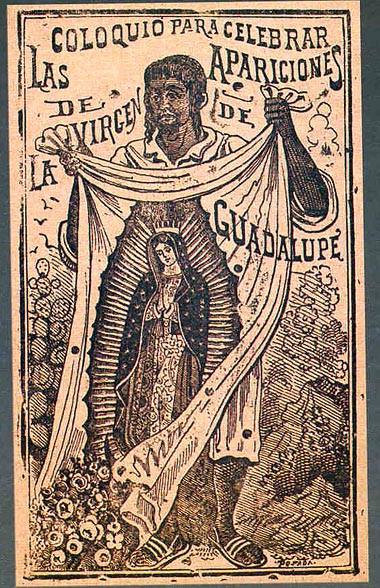“WHAT WOULD YOU SEND ME?” (Lk 1:39-47): 12 December 2007 (The Virgin of Guadalupe, Wednesday)

Reading: www.nccbuscc.org/nab/121207.shtml
We don’t always notice it, but the gospels often depict Mary as being “on the move.” Today’s reading tells us that immediately after the Annunciation, Mary “set out and traveled to the hill country of Judah” to visit her cousin Elizabeth. As we know, for the birth of Christ, she traveled with her husband Joseph to Bethlehem. Almost immediately after that, they escaped to Egypt before returning to Nazareth. According to Luke’s gospel, when Jesus was twelve, the entire family went to Jerusalem for a pilgrimage to the temple. Finally, the gospel according to John reports that she traveled down to Jerusalem to be with her son in his final moments.
Today’s feast reminds us that to this day, Mary hasn’t really stopped traveling. Her Visitation to Elizabeth has been but the first of many that she continues to make. One internet source claims that the more famous Marian apparitions number all of 67 although not all of them are considered official by the Church. These apparitions have occurred as early as the year 39 AD (before her Assumption) when she allegedly appeared to St. James in Caesaraugusta (present-day Zaragoza, Spain) up to the very present. After her Assumption, our Lady has been claimed to travel to places like Banneaux (Belgium), Lourdes and La Salette (France), Fatima (Portugal), and Medjugorie (Bosnia & Herzegovina) , as well as Akita (Japan) and Garabandal (Spain). Lesser known places she has supposedly visited include Bayside in New York, Zeitoun in Egypt, La Vang in Vietnam, and even our own Lipa City. It’s almost as if Mary has simply refused to leave her children behind.
The Feast of the Virgin of Guadalupe recalls a famous visitation in Mexico. In the year 1531, she appears to the peasant Juan Diego and requests him to relay her wish to the bishop that a temple be built on the site. Naturally, the bishop refuses to believe such a tale and asks for a sign. The sign is given: With a piece of cloth called tilma, Juan Diego gathers roses in winter and when he unravels his tilma, the roses come pouring out, and the image of Mary appears imprinted on the cloth.
What I like best about Guadalupe is it doesn’t have the usual doomsday messages associated with many Marian apparitions. The Blessed Mother requests for a church, and when the unbelieving bishop understandably asks for a sign, what does she send him? A bouquet of roses and the portrait of his mother. It was the loveliest of gifts that a mother knows will melt the hardest of hearts.
Today I ask the Blessed Mother: “What would you send me? When I’m not listening and my heart is hard, what gift would you send me?”
During a retreat immediately before my own ordination in 1998, I was plagued with self-doubts, and I felt unworthy of ordination. A recurring image in my prayer was that of a beggar who held an old rusty can of coins. I felt I had nothing to offer God but the “loose change” of my life.
My prayers were uniformly distracted and dry. On the very last day, I sat in the small chapel resigned to the possibility of a failed retreat and perhaps a failed vocation. I entertained thoughts of leaving the seminary a few months before ordination.
And then it happened–a powerful religious experience when it was least expected: Suddenly, the fragrant scent of roses. My first thought was: “Mary.” But almost simultaneously I heard an inner voice that had to belong to her: “No, not me, but you. Your offering is not a can of loose change, but a bouquet of the most fragrant roses.”
It was Mary’s gift for me when I faced the darkest of nights with the weakest of faith. Typical of her, isn’t it? I didn’t recognize it then, but looking back now, I know: It was the grace of Guadalupe. In the cold of winter, I had unravelled my heart to God, and roses came pouring out, revealing her face.
(image: en.wikipedia.org)
There are affordable-papers.net two basic procedures of writing academic papers.